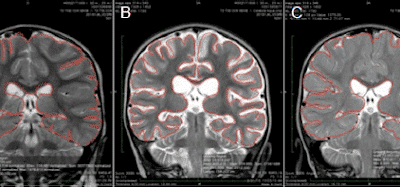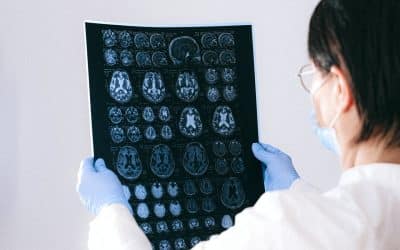Heart rate variability (HRV) represents measurable output of coordinated structural and functional systems within the body and brain. Both mild traumatic brain injury (mTBI) and HRV are modulated by changes in autonomic nervous system function. We present baseline HRV results from an ongoing mTBI clinical trial. HRV was assessed via 24-hour ambulatory electrocardiography; recordings were segmented by physiological state (sleep, wakefulness, exercise, standing still). Time, frequency, and spatial domain measures were summarized and compared with symptoms, sleep quality, and neurological examination. Median low frequency/high frequency (LF/HF) ratio exceeded 1.0 across segments, indicating prevalence of sympathetic modulation. Abnormal Sharpened Romberg Test was associated with 29% LF/HF decrease (95% CI [2.1, 47.7], p=0.04); pathological nystagmus associated with decreased standard deviation of electrocardiogram R-R interval (SDNN) index (25% decrease, 95% CI [0.8, 43.4], p=0.04). Increased sympathetic modulation was associated with increased anger scores (19% LF/HF increase with 5-point State Trait Anger Expression Inventory-2 trait anger increase (95% CI [1.2, 39.1], p=0.04)). A 13% HF increase (95% CI [2.1, 25.7], p=0.02) was observed with increased Pittsburgh Sleep Quality Index scores. These results support autonomic nervous system dysfunction in service members after mTBI.
Brain Damage
Hyperbaric Oxygen Therapy (HBOT) Research for Brain Damage.
TBI study questioned: Dr. Weaver response.
Abstract: Weaver, Lindblad, Wilson, Churchill, Deru, , , , (). TBI study questioned: Dr. Weaver response. Undersea & hyperbaric medicine : journal of the Undersea and Hyperbaric Medical Society, Inc, ;44(1):82-85. https://www.ncbi.nlm.nih.gov/pubmed/28768093
Sleep assessments for a mild traumatic brain injury trial in a military population.
Baseline sleep characteristics were explored for 71 U.S. military service members with mild traumatic brain injury (mTBI) enrolled in a post-concussive syndrome clinical trial. The Pittsburgh Sleep Quality Index (PSQI), sleep diary, several disorder-specific questionnaires, actigraphy and polysomnographic nap were collected. Almost all (97%) reported ongoing sleep problems. The mean global PSQI score was 13.5 (SD=3.8) and 87% met insomnia criteria. Sleep maintenance efficiency was 79.1% for PSQI, 82.7% for sleep diary and 90.5% for actigraphy; total sleep time was 288, 302 and 400 minutes, respectively. There was no correlation between actigraphy and subjective questionnaires. Overall, 70% met hypersomnia conditions, 70% were at high risk for obstructive sleep apnea (OSA), 32% were symptomatic for restless legs syndrome, and 6% reported cataplexy. Nearly half (44%) reported coexisting insomnia, hypersomnia and high OSA risk. Participants with post-traumatic stress disorder (PTSD) had higher PSQI scores and increased OSA risk. Older participants and those with higher aggression, anxiety or depression also had increased OSA risk. The results confirm poor sleep quality in mTBI with insomnia, hypersomnia, and OSA risk higher than previously reported, and imply sleep disorders in mTBI may be underdiagnosed or exacerbated by comorbid PTSD.
Oxygen and hyperbaric oxygen therapy reverses brain damage in drowned toddler
Date: July 17, 2017 Source:Louisiana State University Health Sciences Center Summary: Medical researchers report the case of the reversal of brain volume loss in a 2-year-old drowning victim unresponsive to all stimuli treated with normobaric oxygen (oxygen at sea...
Chronic Diseases as Barriers to Oxygen Delivery: A Unifying Hypothesis of Tissue Reoxygenation Therapy.
Abstract: Modern medical practice has resulted in the accumulation of a growing number of incurable chronic diseases, many of which are inflammatory in nature. Inflammation establishes a hypoxic microenvironment within tissues, a condition of inflammatory hypoxia...
Subacute normobaric oxygen and hyperbaric oxygen therapy in drowning, reversal of brain volume loss: a case report
Abstract: A 2-year-old girl experienced cardiac arrest after cold water drowning. Magnetic resonance imaging (MRI) showed deep gray matter injury on day 4 and cerebral atrophy with gray and white matter loss on day 32. Patient had no speech, gait, or responsiveness to...
Erythropoietin in patients with traumatic brain injury and extracranial injury-A post hoc analysis of the erythropoietin traumatic brain injury trial.
Abstract: Erythropoietin (EPO) may reduce mortality after traumatic brain injury (TBI). Secondary brain injury is exacerbated by multiple trauma, and possibly modifiable by EPO. We hypothesized that EPO decreases mortality more in TBI patients with multiple trauma,...
Concussion diagnosis and management: Knowledge and attitudes of family medicine residents
Abstract Objective: To assess the knowledge of, attitudes toward, and learning needs for concussion diagnosis and management among family medicine residents. Design: E-mail survey. Setting: University of Toronto in Ontario. Participants: Family medicine residents (N =...
Concussion Help in a Hyperbaric Chamber? Local Doctor Says Treatment Can Get Rid of Injury
HBOT for Conussions. An old and familiar piece of technology is being used in the northern suburbs for a whole new reason: to get rid of concussions. Chicago-area doctor Daphne Denham says, when it comes to acute concussions, typically those that have occurred in 10...



